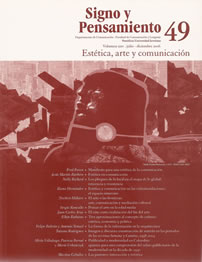Abstract
Today, art works take place in new temporalities and new territories. For instance, time speeding leads to the paradoxical wish of contemporary works of art to be inscribed in the long term of patrimony, and also to the expansion of contemporary art to localized and/or ubiquitous spaces away from art institutions. In this context, more and more domains appear that are open to cultural “mediation “. These developments provide an answer that, though linked to the expansion of the web, responds to people’s and communities’ need to participate in the creation of symbolic forms from which they had been separated by cultural industries. However, the relation between digital art and the aesthetisation process in the realm of communication, as well as the link between communication and communicability (sensus communis), can offer a new approach to the cultural mediation science. The identification of common spaces for aesthetics and communication sciences could help us to deal with these matters: creation, reception, transmission and preservation of art works in the context of a globalized communication culture.Augé, M. (1992), Non-lieux, introduction à une anthropologieb de la surmodernité, París, Le Seuil.
Bataille, G. (1979), “C’est une banalité...”, en Tel Quel, núm. 81.
Baudelaire, Ch. (1976), Ouvres complètes, París, Gallimard.
Bellting, H. (1989), L’histoire de l’art est-elle finie?, París, Nîmes, Jacqueline Chambon.
Couchot, E. (1998), La technologie dans l’art, de la photographie à la réalité virtuelle, París, Nîmes, Jacqueline Chambon.
— (2003, julio-diciembre), “De la communication à la commutation: l’art et le web”, en Hains, R. y
Long, R., “Art et Multimédia” [dossier], Ligeia, núms. 45, 46, 47 y 48, pp. 87-89.
Dupuy, J. P. (1994), “Conférences Macy”, en Aux origines des sciences cognitives, París, La Découverte.
Esenstein, E. (1991), La révolution de l’imprimé à l’aube de l’Europe moderne, París, La Découverte.
Flichy, P. (1991), Une histoire de la communication.
Espace public et vie privée, París, La Découverte.
— (1994), “Technique et innovation. Les sciences sociales et l’innovation” [Note en vue de l’Habilitation à Diriger des Recherches], Université Stendahl-Grenoble III.
— (1995), L’innovation technique, récents développements en sciences sociales, vers une nouvelle théorie de l’innovation, París, La Découverte.
Hillaire, N. (1995), “L’art de la ville monde”, en Light Messenger. Jorge Orta, París, J. M. Place.
— (2000), “Les paradoxes de Sainte Orlan”, en Orlan. Monographie Multimedia, París, Jériko.
Hölderlin, F. (1966), Ouvres, París, Gallimard, La Pléiade.
Jauss, H. (1987), Pour une esthétique de la réception, París, Gallimard.
Lamizet, B. (2000), La médiation culturelle, París, L’Harmattan.
Lévy, P. (1997), Cyberculture, París, Odile Jacob.
Lyotard, J. F. (1988), L’inhumain, causeries sur le temps, París, Galilée.
— (1986), “Quelque chose comme: ‘communication... sans communication’”, en Art et Communication, Osiris, pp. 10-17.
Muntadas, A. (1979-1998), The File Room [en línea] , disponible en http://www.thefileroom.org/File-Room/documents/newhome.html.
Simon, J. P. (1993), “Médiations et histoire sociale de l’art”, en Réseaux, núm. 66, CNET.
Stiegler, B. (1999, octubre), “Manifeste pour une écologie de l’esprit”, en Art Press.

This work is licensed under a Creative Commons Attribution 4.0 International License.
Copyright (c) 2021 Norbert Hillaire


